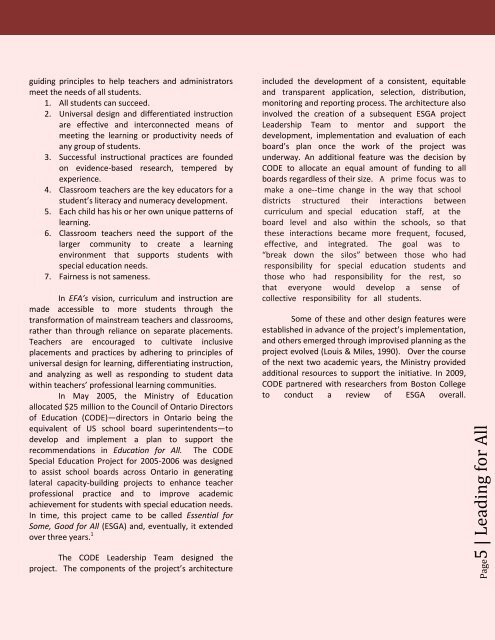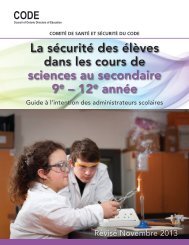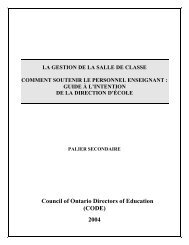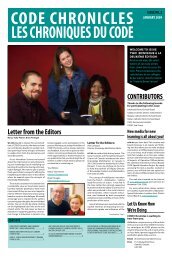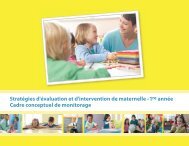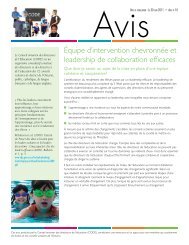Boston College Leading for All: A research report of the ... - CODE
Boston College Leading for All: A research report of the ... - CODE
Boston College Leading for All: A research report of the ... - CODE
You also want an ePaper? Increase the reach of your titles
YUMPU automatically turns print PDFs into web optimized ePapers that Google loves.
guiding principles to help teachers and administratorsmeet <strong>the</strong> needs <strong>of</strong> all students.1. <strong>All</strong> students can succeed.2. Universal design and differentiated instructionare effective and interconnected means <strong>of</strong>meeting <strong>the</strong> learning or productivity needs <strong>of</strong>any group <strong>of</strong> students.3. Successful instructional practices are foundedon evidence-based <strong>research</strong>, tempered byexperience.4. Classroom teachers are <strong>the</strong> key educators <strong>for</strong> astudent’s literacy and numeracy development.5. Each child has his or her own unique patterns <strong>of</strong>learning.6. Classroom teachers need <strong>the</strong> support <strong>of</strong> <strong>the</strong>larger community to create a learningenvironment that supports students withspecial education needs.7. Fairness is not sameness.In EFA’s vision, curriculum and instruction aremade accessible to more students through <strong>the</strong>trans<strong>for</strong>mation <strong>of</strong> mainstream teachers and classrooms,ra<strong>the</strong>r than through reliance on separate placements.Teachers are encouraged to cultivate inclusiveplacements and practices by adhering to principles <strong>of</strong>universal design <strong>for</strong> learning, differentiating instruction,and analyzing as well as responding to student datawithin teachers’ pr<strong>of</strong>essional learning communities.In May 2005, <strong>the</strong> Ministry <strong>of</strong> Educationallocated $25 million to <strong>the</strong> Council <strong>of</strong> Ontario Directors<strong>of</strong> Education (<strong>CODE</strong>)—directors in Ontario being <strong>the</strong>equivalent <strong>of</strong> US school board superintendents—todevelop and implement a plan to support <strong>the</strong>recommendations in Education <strong>for</strong> <strong>All</strong>. The <strong>CODE</strong>Special Education Project <strong>for</strong> 2005-2006 was designedto assist school boards across Ontario in generatinglateral capacity-building projects to enhance teacherpr<strong>of</strong>essional practice and to improve academicachievement <strong>for</strong> students with special education needs.In time, this project came to be called Essential <strong>for</strong>Some, Good <strong>for</strong> <strong>All</strong> (ESGA) and, eventually, it extendedover three years. 1The <strong>CODE</strong> Leadership Team designed <strong>the</strong>project. The components <strong>of</strong> <strong>the</strong> project’s architectureincluded <strong>the</strong> development <strong>of</strong> a consistent, equitableand transparent application, selection, distribution,monitoring and <strong>report</strong>ing process. The architecture alsoinvolved <strong>the</strong> creation <strong>of</strong> a subsequent ESGA projectLeadership Team to mentor and support <strong>the</strong>development, implementation and evaluation <strong>of</strong> eachboard’s plan once <strong>the</strong> work <strong>of</strong> <strong>the</strong> project wasunderway. An additional feature was <strong>the</strong> decision by<strong>CODE</strong> to allocate an equal amount <strong>of</strong> funding to allboards regardless <strong>of</strong> <strong>the</strong>ir size. A prime focus was tomake a one-time change in <strong>the</strong> way that schooldistricts structured <strong>the</strong>ir interactions betweencurriculum and special education staff, at <strong>the</strong>board level and also within <strong>the</strong> schools, so that<strong>the</strong>se interactions became more frequent, focused,effective, and integrated. The goal was to“break down <strong>the</strong> silos” between those who hadresponsibility <strong>for</strong> special education students andthose who had responsibility <strong>for</strong> <strong>the</strong> rest, sothat everyone would develop a sense <strong>of</strong>collective responsibility <strong>for</strong> all students.Some <strong>of</strong> <strong>the</strong>se and o<strong>the</strong>r design features wereestablished in advance <strong>of</strong> <strong>the</strong> project’s implementation,and o<strong>the</strong>rs emerged through improvised planning as <strong>the</strong>project evolved (Louis & Miles, 1990). Over <strong>the</strong> course<strong>of</strong> <strong>the</strong> next two academic years, <strong>the</strong> Ministry providedadditional resources to support <strong>the</strong> initiative. In 2009,<strong>CODE</strong> partnered with <strong>research</strong>ers from <strong>Boston</strong> <strong>College</strong>to conduct a review <strong>of</strong> ESGA overall.Page5 | <strong>Leading</strong> <strong>for</strong> <strong>All</strong>


